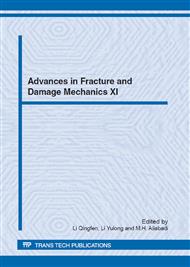[1]
Z. Sharif Khodaei and M. Aliabadi, Damage Identification Using Lamb Waves, Key Engineering Materials, vol. 452, pp.29-32, (2011).
DOI: 10.4028/www.scientific.net/kem.452-453.29
Google Scholar
[2]
I. Benedetti, M. Aliabadi, and A. Milazzo, A fast BEM for the analysis of damaged structures with bonded piezoelectric sensors, Computer Methods in Applied Mechanics and Engineering, vol. 199, pp.490-501, (2010).
DOI: 10.1016/j.cma.2009.09.007
Google Scholar
[3]
Z. Sharif Khodaei, R. Rojas-Diaz, and M. Aliabadi, Lamb-Wave Based Technique for Impact Damage Detection in Composite Stiffened Panels, Key Engineering Materials, vol. 488, pp.5-8, (2012).
DOI: 10.4028/www.scientific.net/kem.488-489.5
Google Scholar
[4]
J. Park, S. Ha, and F. K. Chang, Monitoring Impact Events Using a System-Identification Method, AIAA journal, vol. 47, pp.2011-2020, (2009).
Google Scholar
[5]
M. T. Martin and J. F. Doyle, Impact force identification from wave propagation responses, International Journal of Impact Engineering, vol. 18, pp.65-77, (1996).
DOI: 10.1016/0734-743x(95)00022-4
Google Scholar
[6]
K. Worden and W. J. Staszewski, Impact location and quantification on a composite panel using neural networks and a genetic algorithm, Strain, vol. 36, pp.61-68, (2000).
DOI: 10.1111/j.1475-1305.2000.tb01175.x
Google Scholar
[7]
W. J. Staszewski, K. Worden, R. Wardle, and G. R. Tomlinson, Fail-safe sensor distributions for impact detection in composite materials, Smart Materials and Structures, vol. 9, p.298, (2000).
DOI: 10.1088/0964-1726/9/3/308
Google Scholar
[8]
S. Dae-Un, O. Jung-Hoon, K. Chun-Gon, and H. Chang-Sun, Impact monitoring of smart composite laminates using neural network and wavelet analysis, Journal of intelligent material systems and structures, vol. 11, pp.180-190, (2000).
DOI: 10.1106/n5e7-m37y-3mar-2kfh
Google Scholar
[9]
J. Haywood, P. T. Coverley, W. J. Staszewski, and K. Worden, An automatic impact monitor for a composite panel employing smart sensor technology, Smart Materials and Structures, vol. 14, p.265, (2005).
DOI: 10.1088/0964-1726/14/1/027
Google Scholar
[10]
M. Ghajari, Z. Sharif Khodaei, and M. Aliabadi, Impact Detection Using Artificial Neural Networks, Key Engineering Materials, vol. 488, pp.767-770, (2012).
DOI: 10.4028/www.scientific.net/kem.488-489.767
Google Scholar
[11]
R. Olsson, Mass criterion for wave controlled impact response of composite plates, Composites Part A: Applied Science and Manufacturing, vol. 31, pp.879-887, (2000).
DOI: 10.1016/s1359-835x(00)00020-8
Google Scholar


